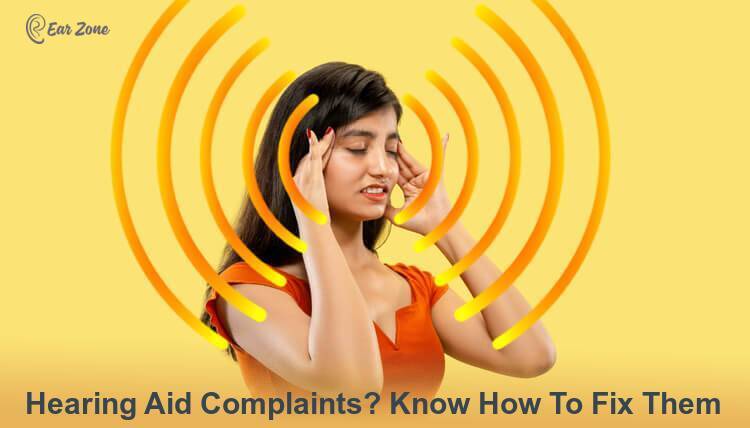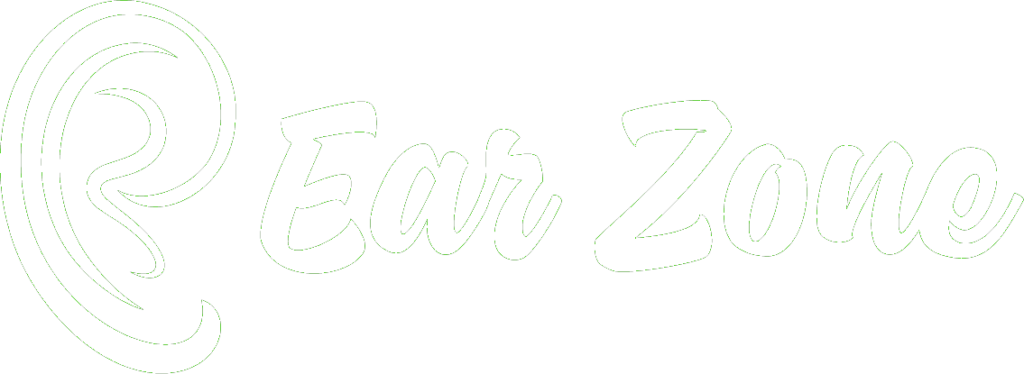Hearing loss is a common problem that affects millions of people around the world. According to WHO, around 430 million people worldwide suffer from some degree of hearing loss. Untreated hearing loss can affect your social life and professional growth. Hearing aids can help you hear sounds you were missing and you can once again communicate with others. But how do hearing aids work? and how do they help you hear? Understanding how hearing aids work is important for you if you are planning on buying one, or you are an existing user.
Table of Contents
What Are Hearing Aids?
Hearing aids are small electronic devices designed to amplify sounds to help you hear if you have difficulty hearing sounds or communicating with others. All hearing aids, irrespective of their style or type pick up sounds around you, process and amplify the sound, and deliver the enhanced sound to your ears through a speaker or receiver, helping you to hear clearly.
How Do Hearing Aids Work?
The different components within the hearing aid contribute to the sound you hear. All types of hearing aids have 4 basic stages:
- Microphone – Picks up sound
- Sound Processor – Modifies the sound to suit your hearing loss pattern
- Amplifier – Amplifies the sound to compensate for your hearing loss
- Receiver or speaker – Delivers the processed and amplified sound into your ears.
The diagram below provides a visual representation of how hearing aids work.
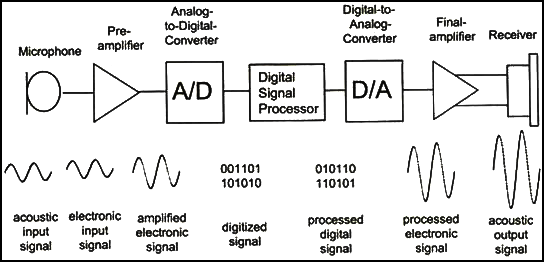
The sound you hear through a digital hearing aid passes through multiple stages. The functions of the various parts are described below:
Microphone
The microphone picks up the speech and the sound around, it converts speech or sound waves to electrical signals and passes them on to the analog to digital converter through a pre-amplifier.
Analog to Digital Converter
Your speech and the surround sound are analog, they have to be converted to a digital signal as analog sound is difficult to process. Digital sound signals can be controlled and enhanced to suit the hearing aid user.
Digital Sound Signal Processor
Every individual’s hearing loss pattern is unique. You may be unable to hear high frequency or sharp and shrill sounds. Similarly, someone else may be having difficulty hearing low frequency or deep bass sounds. The audiologist will input your audiogram into the programming software at the time of fitting the hearing aid. The software will instruct the processor to boost or amplify the frequencies that you are unable to hear. The hearing aid works by compensating the frequencies so you can hear all sounds.
Digital to Analog Converter
Since the human ear can only hear analog sounds, the processed digital sound signal has to be converted back to the analog state before it is delivered to your ears. The digital to analog converter does the job of converting the processed digital signal to analog state.
Sound Amplifier
The sound signal at this stage is not loud enough for you to hear, it has to be amplified to compensate for your hearing loss. The audiogram details that your audiologist fed in the hearing aid programming software also contain details as to how much amplification is required for you to hear well.
The sound amplifier will boost the sound to the required level. You can also increase the amplification by using the volume control if you are unable to hear in certain situations or decrease the sound if it’s too loud and unbearable.
Hearing Aid Receiver
The hearing aid speaker is called a receiver. The receiver or the speaker receives the electrical signal from the amplifier, converts the electrical signal to sound waves, and delivers them to your ears.
This will give you a fairly good idea of how hearing aids work. The basic working of all the hearing aids is the same, whether it’s a BTE, ITC, CIC, or an IIC.
How do Hearing Aids Work for the Deaf?
A hearing aid helps people suffering from sensorineural hearing loss to hear and communicate. Hearing aids are programmed to amplify sounds that a deaf person cannot hear. Sensorineural hearing loss can be due to old age, disease, or damage to the hair cells of the inner ear or the auditory nerve. Hair cells convert the audio into electrical pulses that are carried to the brain by the auditory nerve. The brain interprets these signals as sound.
In case of damage to the hair cells or the auditory nerve, the ability to carry sound signals to the brain is reduced. The greater the damage, the more the amplification required. Your audiologist will test and decide the hearing aid power suitable for you.
How do Bone Conduction Hearing Aids Work?
The conventional hearing aid delivers sound waves to the outer ear, the vibrations generated by the sound waves are conducted by the bones in the middle ear to the inner ear. If due to an accident or a deformity, the outer ear or the middle ear is not capable of passing the sound waves, the person is unable to hear.
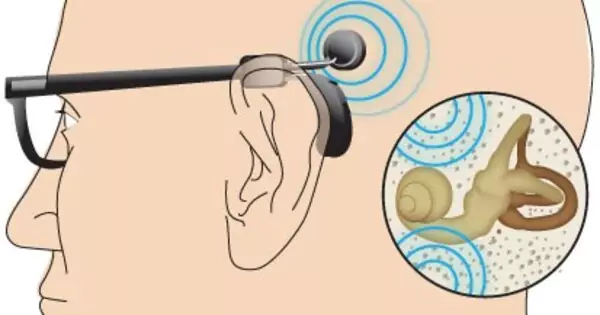
In this case, a bone conduction hearing can help the person to hear. The bone conduction hearing aid converts the sound waves into vibrations, this vibrating device is placed on the mastoid (the hard bone behind your ear), and the mastoid transfers the vibrations to the inner ear without the involvement of the outer or the inner ear. This is how bone conduction hearing aids work. The bone conductor is kept in place by the spectacle arm or a headband.
What is a BAHA?
A BAHA or a bone anchored hearing aid is a medical device. The basic working of BAHA and a bone conduction hearing aid is the same, but unlike a bone conduction hearing aid, a BAHA requires surgery as the titanium abutment has to be surgically implanted behind the ear.
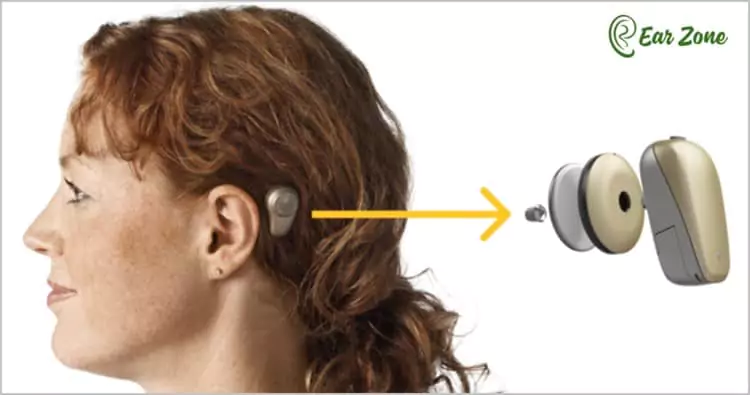
How Does a BAHA Work?
A BAHA consists of two parts, an abutment made of titanium and a processor. The surgeon drills around 4mm deep into the skull and screws on the abutment. The microphone picks up the sound and the processor convert it to vibrations and passes it on to the abutment. The abutment transfers the vibrations to the inner ear. A BAHA is useful if you are suffering from conductive hearing loss.
How Does a Bluetooth Hearing Aid Work?
A Bluetooth hearing aid works by connecting your hearing aid to other Bluetooth enabled devices like a smartphone, tablet, laptop, iPod, or other music streaming devices. A Bluetooth hearing aid is a conventional hearing aid with built-in Bluetooth wireless technology.
You can connect your Bluetooth hearing aid to a smartphone and have a conversation without any external disturbance or listen to music from your iPod or computer. The range of a Bluetooth hearing aid is around 10 meters without obstacles.
How Does a CROS Hearing Aid Work?
CROS or Contralateral Routing of Signal is a system that is suitable if you are suffering from unilateral hearing loss or total hearing loss in one ear. In a CROS system, two hearing aids are connected wirelessly.
The hearing aid on your deaf ear picks up the sound and transmits it to the other hearing aid on good ear so that you do not miss out on any speech or sound from your deaf side. The only drawback is that you will not know from which direction the sound is coming as you will hear everything from your good ear.
How Does a BiCROS Hearing Aid Work?
BiCROS or Bilateral Contralateral Routing of Signal is suitable if one of your ears is totally deaf and the other ear also has some degree of deafness. A BiCROS hearing aid will amplify the sound in the partially deaf ear so you can hear well.
How Do OTC Hearing Aids Work?
An OTC hearing aid or an over-the-counter hearing aid will amplify sound like any other hearing aid but will have minimal controls like volume control and a few preset programs. Irrespective of your hearing loss pattern, you will have to select one of the preset programs.
Some OTC hearing aids may come with a mobile app that will allow a little more flexibility for you to fine tune to hear better.
As per the FDA guidelines, you can use OTC hearing aids if you are over 18 years of age and suffer from mild or moderate hearing loss.
Hearing aid technology is advancing rapidly and brands are adding new features to improve the user’s listening experience. There is a hearing aid for every type of deafness and need. Do not ignore hearing loss, consult your audiologist for the right advice to hear better and enjoy life.


